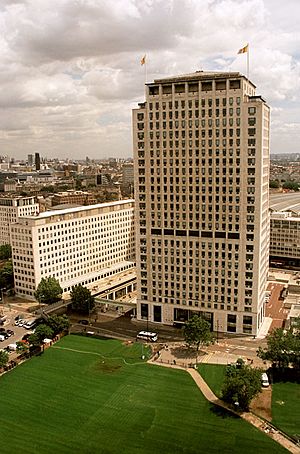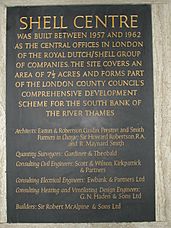Shell Centre facts for kids

The Shell Centre is a famous building in London, England. It's one of the main offices for the big oil company, Shell. The other main office is in The Hague, a city in the Netherlands.
You can find the Shell Centre on Belvedere Road, in an area called London Borough of Lambeth. It's a very noticeable building on the South Bank of the River Thames. It's close to County Hall and is now a backdrop for the London Eye, the giant Ferris wheel.
The original Shell Centre had a tall tower and three smaller buildings next to it. These smaller buildings were called the "Upstream Building" and have since been taken down. There was also another separate building called the "Downstream Building." A railway line separated the Upstream and Downstream buildings.
Shell sold the Downstream Building in the 1990s. It is now a block of apartments called the White House. An extra floor was added to it.
Contents
History of the Shell Centre Site
The Shell Centre stands on land that was cleared for a big event called the Festival of Britain in 1951. The areas closer to the River Thames now have Jubilee Gardens and the South Bank Centre. Jubilee Gardens stayed empty for a long time. This was because of a special rule that stopped any building from being put up between the Shell Tower and the River Thames.
The names "Upstream" and "Downstream" for the Shell Centre buildings came from how the Festival site was divided. The railway bridge for Hungerford Bridge separated these two areas.
Hidden Tunnels Under the Site
During the construction of the Shell Centre, workers found parts of old, unfinished tunnels. These were from a project called the Waterloo and Whitehall Railway. This was meant to be a special railway that would use air pressure to move trains under the River Thames. It would have connected Waterloo and Charing Cross. Digging for this railway started in 1865 but stopped in 1868 because of money problems.
How the Building Stays Cool
If you look closely at the River Thames when the tide is low, you might see some ripples in the water near the tower. This is where the Shell Centre's air conditioning system releases water. The system pulls river water from near County Hall. This water travels through a pipe inside a strong iron tunnel, like a tube railway tunnel. It then goes under the riverbank and Jubilee Gardens to the basement of the tower.
Inside the basement, the water goes through filters and special machines called heat exchangers. These machines use the cool river water to make cool air for the building. The pipes had to be specially supported in 1995. This was during the digging for the Jubilee line extension of the London Underground.
Building Design and Features
The Shell Centre buildings were covered in a type of stone called Portland Stone. They also had individual windows with bronze frames. Some critics of the Modern Movement in architecture thought the buildings looked boring. However, because of the traditional stone, the buildings have aged better than many others from the same time. Many other buildings used concrete or glass, which didn't last as well.
The inside of the original buildings was very fancy. British designers worked on it, and some had also worked on the Festival of Britain. An Italian designer named Ernesto Nathan Rogers also helped. The building had great facilities for staff, like a full-size swimming pool and a large gym in the basement.
The basement also used to have a rifle range, a snooker room, and a small supermarket for staff. Until 1998, there was even a fully equipped theatre. It was designed by Cecil Beaton and was special because it had a "fly tower" for moving scenery, which is rare for amateur theatre spaces.
Artworks at the Shell Centre
The courtyard of the Upstream Building had two important sculptures:
- "Torsion Fountain" by Franta Belsky: This was a tall bronze sculpture shaped like shells. Water used to flow from one shell to another.
- "Motorcyclist" by Siegfried Charoux: This was a large sculpture of a person riding a motorcycle.
Over the years, the public areas around the Upstream Building changed. The wide space at the entrance from York Road was enclosed to make the lobbies bigger. Special textured paving was put down to help people who couldn't see well. This paving also helped to stop homeless people from sleeping there and skateboarders from using the area.
Building Construction Details
The company Sir Robert McAlpine built the Shell Centre between 1957 and 1962. The design was by Sir Howard Robertson. The tower is 107 metres (351 ft) tall and has 27 floors. Three more floors are underground. The Shell Centre tower was the first office tower in London to be taller than the Victoria Tower of the Palace of Westminster.
It became the tallest storied building in London, taking the title from the Midland Grand Hotel. It also became the tallest building in the United Kingdom, surpassing the Royal Liver Building. When it was finished, it was also the largest office building in Europe based on its floor space.
What Happens at the Shell Centre Today
Some parts of Shell's business are run from the Shell Centre. This includes refining oil and selling products. It also handles support tasks like finance and human resources. The Shell Centre is also the main office for Shell's business in the United Kingdom (Shell UK Ltd.). This office used to be in a building called Shell Mex House.
In 2004, a plan was approved to turn the lower floors of the Upstream Building courtyard and the old staff cafeteria into a shopping centre. There were also plans to build a new glass office building on a space called the Podium Site to the south. The sculptures would be moved to new locations.
In 2009, Shell staff were told about a plan to rebuild most of the site, but leave the tower standing. This would mean staff would have to move out for up to seven years while construction happened. The new plans would use some of the open spaces around the current building.
In July 2011, Shell announced that two companies, Canary Wharf Group and Qatari Diar, had bought a very long lease (999 years) on the Shell Centre for £300 million. They planned to redevelop the site. The tower would stay, but the rest of the area would be replaced with new offices, shops, and restaurants. This new development is called Southbank Place.
New Year's Eve Celebrations
During London's New Year's Eve celebrations, the Shell Centre tower lights up. At exactly 11:59 PM, the last sixty seconds of the old year are projected onto the tower. This countdown is perfectly timed with the chimes of Big Ben.


